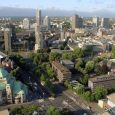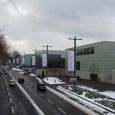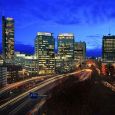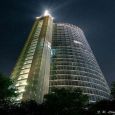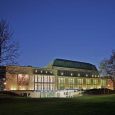Essen
Advertisement
By Air
Together with the neighbouring city of Mülheim an der Ruhr and the state of North Rhine-Westphalia, Essen maintains Essen/Mülheim Airport (IATA: ESS, ICAO: EDLE). While the first flights had already arrived in 1919, it was officially opened on August 25, 1925. Significantly expanded in 1935, Essen/Mülheim became the central airport of the Ruhr area until the end of the Second World War, providing an asphalted runway of 1,553 m (5,095 ft), another unsurfaced runway for gliding and destinations to most major European cities. It was heavily damaged during the war, yet partly reconstructed and used by the Allies as a secondary airport since visibility is less often obscured there than at Düsseldorf Airport. The latter then developed into the large civil airport that it is now, while Essen/Mülheim nowadays mainly serves occasional air traffic (some 33,000 passengers each year, the base of a fleet of airships and Germany's oldest public flight training company. Residents of the region around Essen typically use Düsseldorf Airport (20 driving minutes) and occasionally Dortmund Airport for both domestic and international flights.
By Train
Of the Rhein-Ruhr S-Bahn net's 13 lines, 5 lines lead through Essen territory and meet at the Essen Hauptbahnhof main station, which also serves as the connection to the Regional-Express and Intercity-Express network of regional and nationwide high-speed trains, respectively. Following Essen's appointment as European Capital of Culture 2010, the main station, which is classified as a station of highest importance and which had not been substantially renovated over decades, will be redeveloped with a budget of € 57 million until early 2010.Other important stations in Essen, where regional and local traffic are connected, are the Regionalbahnhöfe (regional railway stations) in the boroughs of Altenessen, Borbeck, Kray and Steele. Further 20 S-Bahn stations can be found in the whole urban area.
By Bus
EVAG operates 3 U-Stadtbahn, 7 tram and 59 bus lines (16 of these serving as Nacht Express late-night lines only), with a total length of 29 kilometres (18 mi), 83 kilometres (52 mi) and 459 km (285 mi), respectively.One tram line and a few bus lines coming from neighboring cities are operated by these cities' respective carriers. The U-Stadtbahn, which partly runs on used Docklands Light Railway stock, is a mixture of tram and full underground systems with 20 underground stations for the U-Stadtbahn and additional 4 underground stations used by the tram. Two lines of the U-Stadtbahn are completely intersection-free and hence independent from other traffic, and the U 18 line leading from Mülheim main station to the Berliner Platz station at the gates of the city center partly runs above ground amidst the A 40 motorway. On the same motorway, a long-term test of a guided bus system is being held since 1980. Many EVAG rail lines meet at the main station but only a handful of bus lines. However, all but one of the Nacht Express bus lines originate from / lead to Essen Hauptbahnhof in a star-shaped manner. All EVAG lines, including the Nacht Express lines, are closed on weekdays from 1:30 a.m. to 4:30 a.m.
By Road
The road network of Essen consists of over 3,200 streets, which in total have a length of roughly 1,600 km (994 mi).
Advertisement
Museum Folkwang
Museum Folkwang is a major collection of 19th and 20th century art in Essen, Germany. The museum was established in 1922 by merging the Essener Kunstmuseum, which was founded in 1906, and the private Folkwang Museum of the collector and patron Karl Ernst Osthaus in Hagen, founded in 1901.
The term Folkwang derives from the name of the afterlife meadow of the dead, Fólkvangr, presided over by the Norse goddess Freyja.Museum Folkwang incorporates the Deutsche Plakat Museum (German poster museum), whose circa 340 000 posters from politics, economy and culture. Paul J. Sachs called it: "The most beautiful museum in the world".
Zollverein Industrial Complex
The Zollverein Industrial Complex is the city's most famous landmark. For decades, the coal mine (current form mainly from 1932, closed in 1986) and the coking plant (closed in 1993) ranked among the largest of their kinds in Europe. Shaft XII, built in Bauhaus style, with its characteristic winding tower, which over the years has become a symbol for the whole Ruhr area, is considered an architectural and technical masterpiece, earning it a reputation as the "most beautiful coal mine in the world".After UNESCO had declared it a World Heritage Site in 2001, the complex, which had lain idle for a long time and was even threatened to be demolished, began to see a period of redevelopment. Under the direction of an agency borne by the land of North Rhine-Westphalia and the city itself, several arts and design institutions settled mainly on the grounds of the former coal mine; a redevelopment plan for the coking plant is to be realised.
Red Dot Museum
The red dot design award is a large and coveted international product design prize awarded by the Design Zentrum Nordrhein Westfalen in Essen, Germany. The aim of the prize is to honor outstanding design quality and trendsetters. Since 1955, designers and producers can apply for the prizes with the winners being presented in an annual ceremony. Winning products are presented in the red dot design museum on the premises of the Zollverein World Cultural Heritage site in Essen.
With more than 11,000 submissions from 61 countries, the international “red dot design award” is the largest and most renowned design competition in the world. The red dot is awarded in three different categories.
Villa Hugel
The Villa Hugel is a mansion in Bredeney (part of the modern city of Essen) in Germany. It belonged to the Krupp family of industrialists and was built by Alfred Krupp during 1873 as a residence. More recently, the Villa Hugel is the main office of the Alfried Krupp von Bohlen and Halbach Foundation (major shareholder of the Thyssen-Krupp corporation) and houses an art gallery. The archive of the Krupp family and company is also located there.
The house has 259 rooms and occupies 8,100 m². It lies in a 28 hectare park overlooking the River Ruhr and the Baldeneysee.
Kettwig and Werden
Kettwig and Werden in the south of the city, the boroughs of Kettwig and Werden exceptionally stand for towns once of their own, which have been annexed in the mid-20th century and which have largely preserved their pre-annexation character. While most of the northern boroughs were heavily damaged during the Second World War and often lost their historic town centres; the more southern parts got off more lightly.
In Werden, St. Ludger founded Werden Abbey around 799, 45 years before St. Altfrid founded the later cornerstone of the modern city, Essen Abbey. The old church of Werden abbey, St. Ludgerus, was designated a papal basilica minor in 1993, while the main building of the former abbey today is the headquarters of the Folkwang University of music and performing arts.
Saalbau
Saalbau the home of the Essen Philharmonic Orchestra, completely renovated in 2003/2004. Critics have repeatedly voted the Essen Philharmonic as Germany's Orchestra of the Year.
Information not available
July - August -> 18(°C) - Summer
January - May -> 3(°C) - Winter
Advertisement

